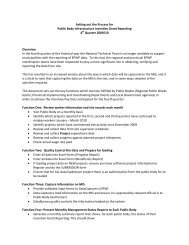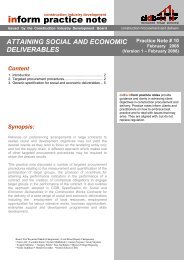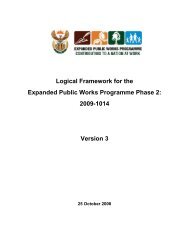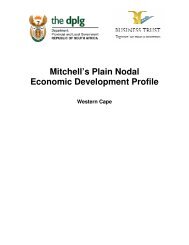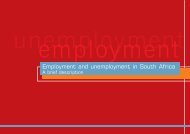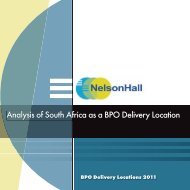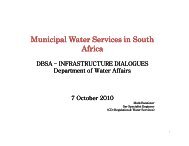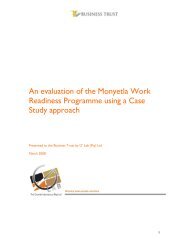National Infrastructure Maintenance Strategy - Construction Industry ...
National Infrastructure Maintenance Strategy - Construction Industry ...
National Infrastructure Maintenance Strategy - Construction Industry ...
Create successful ePaper yourself
Turn your PDF publications into a flip-book with our unique Google optimized e-Paper software.
terminals, baggage handling and lifts and air<br />
bridges. Statutory requirements rule here also - in<br />
particular those of the (South African) Civil Aviation<br />
Authority, the (USA) Federal Aviation Authority<br />
with respect to security, and those of the<br />
Occupational Safety and Health Act.<br />
ACSA also pays close attention to the condition of<br />
runways and aprons - the company runs a<br />
sophisticated pavement management system,<br />
kept up-to-date by weekly visual inspections,<br />
recording of all work done, and annual<br />
assessments of Remaining Useful Life.<br />
<strong>Infrastructure</strong> asset management is governed by<br />
the "ACSA <strong>Maintenance</strong> Policy Document", which<br />
sets out the life-cycle replacement policy and<br />
programmes, and policy and programmes for the<br />
review of the status (i.e. wear and tear, and<br />
obsolescence) of assets.<br />
All the airports have standby generators, of<br />
sufficient capacity to meet the power needs of<br />
runway ground lighting, air bridges, baggage<br />
handling, security, and emergency lighting within<br />
terminals, should the external power source (e.g.<br />
Eskom) fail. (But not to meet the needs of, for<br />
example, escalators and air-conditioning.)<br />
Budgets for infrastructure management are<br />
reported to be very close to the optimum. There is<br />
no maintenance backlog to speak of.<br />
ACSA has a more or less adequate technical staff<br />
resource at all levels, more than competent<br />
enough to manage its infrastructure.<br />
Current initiatives to enhance maintenance<br />
Improvement of current procedures is constantly<br />
sought. For example, trials are currently underway<br />
of round-the-clock electronic condition monitoring<br />
systems for component parts of the baggage<br />
handling system and of pumping equipment. Such<br />
systems will enable earlier identification of<br />
components about to fail (and therefore their<br />
timeous replacement, leading to greater reliability<br />
of operation of the infrastructure).<br />
Summary<br />
In summary, the key factor pertinent to the state of<br />
ACSA's infrastructure has been its strong financial<br />
state, and in particular its ability over the years to<br />
budget adequately for maintenance and<br />
replacement. Statutory requirements for safety<br />
and reliability, and the company's own<br />
maintenance policy and strong maintenance ethic<br />
have also been instrumental.<br />
h. Transnet<br />
Overview of Transnet's infrastructure and service<br />
delivery<br />
The core elements of the business of Transnet<br />
(since 1989 a SOE, and wholly owned by the<br />
Department of Transport) are rail, ports and<br />
pipelines. While it has been agreed that the<br />
operational function of each of these will be<br />
separated from the infrastructure function, this<br />
has only been implemented in respect of ports.<br />
<strong>Infrastructure</strong> and service delivery in respect of the<br />
following three entities is described in this section<br />
of Annexure A:<br />
• Spoornet (long-distance rail services);<br />
• <strong>National</strong> Ports Authority (NPA); and<br />
• SA Port Operations (SAPO).<br />
The NPA is responsible for the seven commercial<br />
ports, and for their infrastructure, including the<br />
harbours and quaysides themselves, harbour<br />
buildings, tug and pilot services, dredging and<br />
aids to navigation. SAPO is responsible for<br />
equipment such as straddle carriers, cranes and<br />
conveyor belts, and terminals (such as grain<br />
elevators) and their equipment.<br />
State of infrastructure and state of maintenance<br />
The financial state of Transnet has been highly<br />
material to the state of its infrastructure. Transnet<br />
has been posting substantial losses ever since it<br />
”inherited massive accumulated losses from South<br />
African Transport Services at the time of its<br />
inception in 1990" ("The DBSA <strong>Infrastructure</strong><br />
Barometer 2006", page 72). The recent turnaround<br />
national infrastructure maintenance strategy<br />
26



